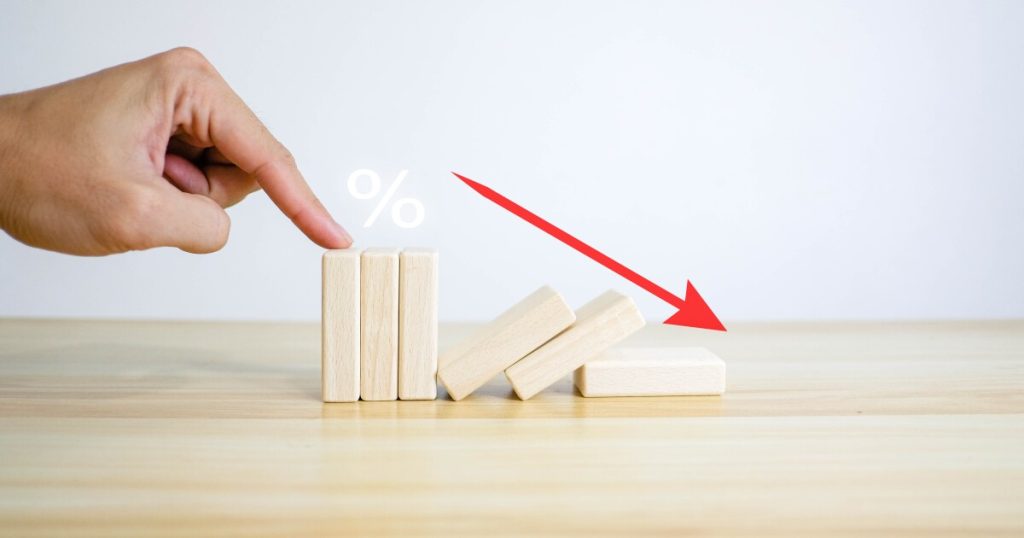- Key insights: Banks are by and large lowering interest rates on deposit accounts.
- Expert quote: “Until loan growth really comes back in a more significant way, what we’re hearing from banks is that there’s more of a focus on cost and efficiency as opposed to deposit growth,” said one observer.
- Forward look: Additional Fed cuts are expected to spur more rate reductions, but there’s uncertainty about the size and speed of the coming changes.
How much will banks’ deposit costs fall, and how fast? That question is likely to be front and center during earnings season, which kicks off on Oct. 14, four weeks after the Federal Reserve resumed interest rate cuts.
Data from September suggests that most banks are unsurprisingly eager to trim the rates they pay to savers, though there may be some outliers that see opportunities for loan growth and remain willing to pay up for funding.
At banks and credit unions that offer certificates of deposits, 91% of the changes made on CDs last month were rate decreases, according to CD Valet, which tracks rates across the industry.
There were four times as many rate decreases in September as there were in August, and the average drop was 25 basis points, which matched the Fed’s
“Banks are dying to see rates go down,” said John Blizzard, the founder of CD Valet and the president and CEO of Seattle Bank, which has the same corporate parent as CD Valet. “I think you’re going to see banks aggressively moving their rates lower.”
Deposit costs have been a thorny issue for banks ever since the Fed began rapidly lifting rates in 2022 to try to curb post-pandemic inflation. By and large, banks boosted the interest they paid on savings accounts and CDs, especially CDs with shorter terms, largely due to competition.
After more than two years of rate hikes, the Fed made three cuts last year, then paused action until mid-September, when the Federal Open Market Committee voted 11-1 to approve the one-quarter-percentage point reduction. The only dissenter was Stephen Miran, a White House economist who was
Analysts generally expect two more Fed rate cuts before the end of the year.
Broadly speaking, banks have sought to reduce their interest rates across all business lines this year in order to shrink their funding costs, said Adam Stockton, a managing director at the consulting firm Curinos. Deposit costs can eat into banks’ net interest margins, a key profitability metric that shows the amount of interest paid out versus interest received.
In September, about half of the 1,000-plus banks that Curinos tracks lowered their interest rates on CDs and high-yield savings accounts, with an average reduction of about 10 basis points, Stockton said. About half of them acted before the Fed’s rate cut, and half did so after, Stockton said.
And there’s likely more to come, at least until loan growth picks up in a meaningful way.
“We expect banks broadly to be pretty aggressive with pricing because the market expectation is that rates are going to continue to come down over the coming months,” Stockton said.
“Until loan growth really comes back in a more significant way, what we’re hearing from banks is that there’s more of a focus on cost and efficiency as opposed to deposit growth.”
Ken Tumin, a longtime deposit-rate tracker who recently co-founded DepositQuest.com, follows online banks’ rates. He estimates that at least 25% of online banks have reduced the interest rates they’re paying on high-yield savings accounts and CDs since the Fed’s cut last month.
To be sure, some banks may decide to maintain or lift their rates to draw more deposits, possibly to
“If a bank is hungry for deposits and everyone is lowering rates, it can be a great time to go out and offer something higher,” Blizzard said.
Some analysts are watching to see if deposits costs actually decrease in the near term.
In a recent research note, analysts at Morgan Stanley cautioned that banks’ net interest margin expansion could be hampered by an acceleration of loan growth and increased competition for deposits.
Read more about deposits here:
One thing seems clear: Consumers are much more savvy and informed about deposit rates than they were a few years ago, and that may have an impact on how quickly banks can lower rates.
“I think this spurt of high interest rates, after so many years where rates were so low, has helped get a lot of consumers’ attention to the rates being offered,” he said. “And I think that will keep them on the lookout for rate opportunities.”

